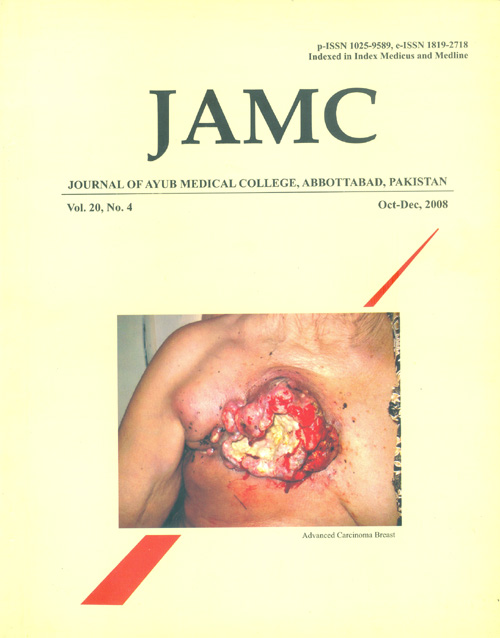PATTERN OF CHANGE IN THE FREQUENCY OF HELICOBACTER PYLORI WITH PERFORATED DUODENAL ULCER
Abstract
Background: Peptic ulcers were believed to be caused by stress, dietary factors, and gastric acid,but the link between H. pylori and peptic ulcers was identified in 1983. To see the frequency of
Helicobacter pylori infection in patients with perforated duodenal ulcer and advise eradication
therapy in these patients. This cross sectional study was conducted in Surgical Unit Hayatabad
Medical Complex, Peshawar, during January 2007-June 2008. Methods: A total of 50 cases were
included in the study. All cases presenting to our unit with acute perforated duodenal ulcer were
recruited. After resuscitation and baseline investigations, all underwent emergency laparotomy via
upper midline incision, after thorough peritoneal lavage, the perforation margins were freshened
and closed over an omental patch. Serum from every patient was tested for H. pylori and
accordingly managed. Results: Out of the 50 cases, 45 were males, and 5 were females. Age
ranged from 20- 80 years old. All patients underwent emergency laparotomy. Postoperatively, all
were started on PPI treatment and serum testing for H. pylori was done. Thirty-four (68%) turned
out positive and 16 (32%) were found to be negative for H. pylori. Conclusion: There is still a high
frequency of H. pylori infection in patients with perforated duodenal ulcer. But comparing these
results with the various data available, there is a significant decline in H pylori positive perforated
duodenal ulcer patients.
Keywords: Peptic ulcer, Helicobacter pylori infection, Proton pump inhibitors
References
Marshall BJ, Warren JR. Unidentified curved bacilli in the
stomach of patients with gastric and peptic ulcerations. Lancet
;323:1311-15.
Rauwi EJ, Tygat GN. Helicobacter Pylori in Duodenal and
Gastric Ulcer Disease. B'allieres Clinic Gastroenterology
;9:529-47.
Goodwin CS, Mendall MM, Northfield TC. Helicobacter
Pylori Infection. Lancet 1997;349:265-9.
Brown LM. Helicobacter Pylori: Epidemiology and Modes of
Transmission. Epidemiol Rev 2000;22:283-97.
Bode G, Rothenbacher D, Brenner H, Adler G. Helicobacter
pylori and abdominal Symptoms: A Population based Study
Among Pre-school Children in Southern Germany. Pediatrics
;101:634-7.
Malaty HM, Logan ND, Graham DY, Ramchatesiugh JE.
Helicobacter Infection in Pre-school and School Aged
Minority Children: Effect of Socio-economic Indication and
Breastfeeding Practices. Clin Infectious Diseases
;32:1377-82.
Jyotheees WS, Shah AN, Jin HO, Potler GD, Ona FV, Chey
WY. Prevalence of Helicobacter pylori in peptic ulcer patients
in greater Rochester, NY. Is empirical therapy justified? Am J
Gastoenterol 1998;93:574-8.
Xia HHX, Phung N, Kalander J, Talley NJ. Characteristic of
Helicobacter pylori positive and negative peptic ulcer disease.
Digestive diseases week 1999;A245:1365.
Frendrick AM, outcomes research in helicobacter pylori
infection. Alimentary Pharmacology and Therapeutics
;11(Suppl 1):95-101.
Meier R, Wettestein AR. Treatment of Acute Nonvariceal
Upper Gastrointestinal Hemorrhage. Digestion
;60:47-52.
Boey J, Branick FJ,Alagaratnam TT, Fok PJ, Choi S, Poon A,
Wong J. Proximal Gastric Vagotomy: The Preferred
Operation for Perforations in Acute Duodenal Ulcers. Ann
Surg 1998;208:169-74.
Jordan PH, Jr, Korompai FL. Evolvement of a new treatment
for perforated duodenal ulcer. Surg Gynecol Obstet
;142:391-5..
Svanes C. Trends in Perforated Peptic Ulcer: Incidence,
Etiology, Treatment, and Prognosis. World J Surg
;24:277-83.
Alizadeh N, Buhler L, Huber O, Morel P. Conservative
Treatment of Gastroduodenal Peptic Ulcer Perforations:
Indications and Results. Schweiz Med Wochenschr Supp
;89:175-95.
Pescatore P, Holkic N, Calmes JM, Blum A, Gillet M.
Combined Laparoscopic Endoscopic Method Using an
Omental Plug for the Therapy of Gastroduodenal Ulcer
Perforation. Gastrointestinal Endoscopy 1998;48:411-4.
Sharma AK, Mittal S, Malvi SK: Association of Helicobacter
pylori with perforation in Chattisgarh region of India. Trop
Gastroenterol 2000;21:42-3.
Ng EK, Chung SC, Sung JJ, Lam YH, Lee DW, Lau JY, et al.
High Prevalence of H Pylori Infection In Duodenal Ulcer
Perforation not Caused by non-steroidal anti-inflammatory
drugs. Br J Surg 1996;83:1779-81.
Aman Z, Afridi V, Khan J. Prevalence of H. Pylori in
Perforated Peptic Ulcer. J Postgrad Med Inst
;16(2):195-9.
Graves EJ. Detailed Diagnoses and Procedures, National
Discharge Survey, 1993. National Health Statistics. Vital
Health Stat 1995;122:1-288. Available from:
http://www.cdc.gov/nchs/products/series.htm
Popovic JR, Kozac LJ. National Hospital Discharge Survey:
Annual Summary 1998. National Center for Health Statistics.
Vital Health Stat 2000;148:1-194. Available from:
Published
How to Cite
Issue
Section
License
Journal of Ayub Medical College, Abbottabad is an OPEN ACCESS JOURNAL which means that all content is FREELY available without charge to all users whether registered with the journal or not. The work published by J Ayub Med Coll Abbottabad is licensed and distributed under the creative commons License CC BY ND Attribution-NoDerivs. Material printed in this journal is OPEN to access, and are FREE for use in academic and research work with proper citation. J Ayub Med Coll Abbottabad accepts only original material for publication with the understanding that except for abstracts, no part of the data has been published or will be submitted for publication elsewhere before appearing in J Ayub Med Coll Abbottabad. The Editorial Board of J Ayub Med Coll Abbottabad makes every effort to ensure the accuracy and authenticity of material printed in J Ayub Med Coll Abbottabad. However, conclusions and statements expressed are views of the authors and do not reflect the opinion/policy of J Ayub Med Coll Abbottabad or the Editorial Board.
USERS are allowed to read, download, copy, distribute, print, search, or link to the full texts of the articles, or use them for any other lawful purpose, without asking prior permission from the publisher or the author. This is in accordance with the BOAI definition of open access.
AUTHORS retain the rights of free downloading/unlimited e-print of full text and sharing/disseminating the article without any restriction, by any means including twitter, scholarly collaboration networks such as ResearchGate, Academia.eu, and social media sites such as Twitter, LinkedIn, Google Scholar and any other professional or academic networking site.









